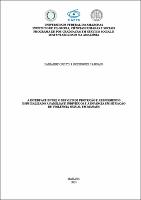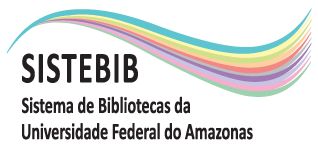| ???jsp.display-item.social.title??? |


|
Please use this identifier to cite or link to this item:
https://tede.ufam.edu.br/handle/tede/11233| ???metadata.dc.type???: | Dissertação |
| Title: | A interface entre o Serviço de Proteção e Atendimento Especializado a Famílias e Indivíduos e à infância em situação de violência sexual em Manaus. |
| Other Titles: | The Interface Between The Protection Service And Specialized Support For Families And Individuals and children in situations of sexual violence in Manaus |
| ???metadata.dc.creator???: | Sampaio, Fabianne Cristina Rodrigues  |
| ???metadata.dc.contributor.advisor1???: | Fernandez, Cristiane Bonfim |
| ???metadata.dc.contributor.referee1???: | Rolim, Dayana Cury |
| ???metadata.dc.contributor.referee2???: | Duarte, Natália de Souza |
| ???metadata.dc.description.resumo???: | O objetivo geral deste estudo é analisar a atuação do Serviço de Proteção e Atendimento Especializado a Famílias e Indivíduos - PAEFI, junto às crianças em situação de violência sexual e suas famílias, em Manaus. São objetivos específicos: 1) Desvelar as ações do PAEFI junto às crianças em situação de violência sexual e suas famílias; 2) Caracterizar o perfil das crianças em situação de violência sexual (e de suas famílias) atendidas nos serviços PAEFI; e 3) Refletir de que forma a articulação da rede intersetorial instiga as ações do PAEFI para o atendimento das crianças em situação de violência sexual e das suas famílias. O lócus da pesquisa foram os Centros de Referência Especializado de Assistência Social - CREAS de Manaus. Trata-se de uma pesquisa qualitativa, de caráter empírico. O referencial metodológico escolhido foi a Hermenêutica da Profundidade. Para coleta de dados, foram usados questionários, entrevistas e diálogo lúdico. Os sujeitos da pesquisa foram 19 trabalhadores da Assistência Social municipal e 8 usuários (crianças e responsáveis familiares). Os resultados da pesquisa apontam que a implementação do PAEFI tem contribuído para o fortalecimento da função protetiva da família e impacta positivamente a convivência familiar e comunitária, havendo, todavia, limitações e fragilidades na execução, como recursos humanos e materiais insuficientes. Quanto ao perfil das crianças, prevalecem meninas (79%) entre 7 e 11 anos (69%), autodeclaradas pardas, a maioria (75%) no ensino fundamental I, que vivenciaram, predominantemente, abuso sexual praticado, em maioria, por agressores com vínculo familiar. No que se refere à avaliação das crianças, o acompanhamento foi positivo, entretanto, nem todas entendem o motivo pelo qual estão realizando os atendimentos. A pesquisa aponta que os responsáveis são de ambos os sexos e não somente genitores, possuem entre 30 a 49 anos, preponderantemente pardos, com ensino médio e atuam como trabalhadores informais. No que se refere à visão dos responsáveis, conclui-se uma avaliação positiva com impactos satisfatórios na vida das famílias, incluindo o acesso a outras políticas públicas, mudanças comportamentais e emocionais saudáveis na convivência familiar/comunitária, mesmo com as fragilidades sinalizadas pelos profissionais. Sobre a articulação intersetorial, identificamos que ela existe, mas foi avaliada diferente entre profissionais e gestores, indicando que, para os técnicos, persiste a necessidade de fortalecimento da rede intersetorial. Sendo assim, a interface entre o PAEFI e a infância violada aponta que o serviço é desenvolvido considerando a realidade de cada território e as suas limitações. É importante, porém, repensar novas metodologias de atendimentos, especialmente para as crianças, e uniformizar as informações dos CREAS. |
| Abstract: | The overall objective of this study is to analyse the work of the Specialised Protection and Assistance Service for Families and Individuals (PAEFI) with children who have experienced sexual violence and their families in Manaus. The specific objectives are: 1) To reveal the actions of PAEFI with children in situations of sexual violence and their families; 2) To characterise the profile of children in situations of sexual violence (and their families) served by PAEFI services; and 3) To reflect on how the articulation of the intersectoral network instigates PAEFI's actions to assist children in situations of sexual violence and their families. The research was conducted at the Specialised Social Assistance Reference Centres (CREAS) in Manaus. This is a qualitative, empirical study. The chosen methodological framework was Depth Hermeneutics. Data were collected using questionnaires, interviews and playful dialogue. The research subjects were 19 municipal social workers and 8 users (children and family guardians). The results of the research indicate that the implementation of PAEFI has contributed to strengthening the protective role of the family and has a positive impact on family and community life. However, there are limitations and weaknesses in its execution, such as insufficient human and material resources. As for the profile of the children, girls (79%) between the ages of 7 and 11 (69%) prevail, self-declared as brown-skinned, the majority (75%) in primary school, who predominantly experienced sexual abuse, mostly by perpetrators with family ties. With regard to the assessment of the children, the follow-up was positive, however, not all of them understand the reason why they are receiving treatment. The research indicates that the guardians are of both sexes and not only parents, are between 30 and 49 years old, predominantly brown-skinned, have a secondary education and work as informal workers. With regard to the guardians' perspective, the assessment was positive, with satisfactory impacts on family life, including access to other public policies and healthy behavioural and emotional changes in family/community life, even with the weaknesses identified by professionals. Regarding intersectoral coordination, we identified that it exists, but it was evaluated differently between professionals and managers, indicating that, for technicians, there is a continuing need to strengthen the intersectoral network. Thus, the interface between PAEFI and abused children shows that the service is developed considering the reality of each territory and its limitations. However, it is important to rethink new service methodologies, especially for children, and to standardise CREAS information. |
| Keywords: | Crime sexual contra as crianças - Assistência social Crianças - Maus-tratos - Assistência social Crianças maltratadas sexualmente - Assistência social |
| ???metadata.dc.subject.cnpq???: | CIENCIAS SOCIAIS APLICADAS: SERVICO SOCIAL |
| ???metadata.dc.subject.user???: | PAEFI Crianças Infâncias Direitos Humanos Violências Sexuais |
| Language: | por |
| ???metadata.dc.publisher.country???: | Brasil |
| Publisher: | Universidade Federal do Amazonas |
| ???metadata.dc.publisher.initials???: | UFAM |
| ???metadata.dc.publisher.department???: | Instituto de Filosofia, Ciências Humanas e Sociais |
| ???metadata.dc.publisher.program???: | Programa de Pós-graduação em Serviço Social |
| Citation: | SAMPAIO, Fabianne Cristina Rodrigues. A interface entre o Serviço de Proteção e Atendimento Especializado a Famílias e Indivíduos e à indância em situação de violência sexual em Manaus. 2025. 144 f. Dissertação (Mestrado em Serviço Social) - Universidade Federal do Amazonas, Manaus (AM), 2025. |
| ???metadata.dc.rights???: | Acesso Aberto |
| ???metadata.dc.rights.uri???: | https://creativecommons.org/licenses/by-nc-nd/4.0/ |
| URI: | https://tede.ufam.edu.br/handle/tede/11233 |
| Issue Date: | 28-Aug-2025 |
| Appears in Collections: | Mestrado em Serviço Social |
Files in This Item:
| File | Description | Size | Format | |
|---|---|---|---|---|
| DISS_FabianneSampaio_PPGSS | 2.3 MB | Adobe PDF |  Download/Open Preview |
Items in DSpace are protected by copyright, with all rights reserved, unless otherwise indicated.




